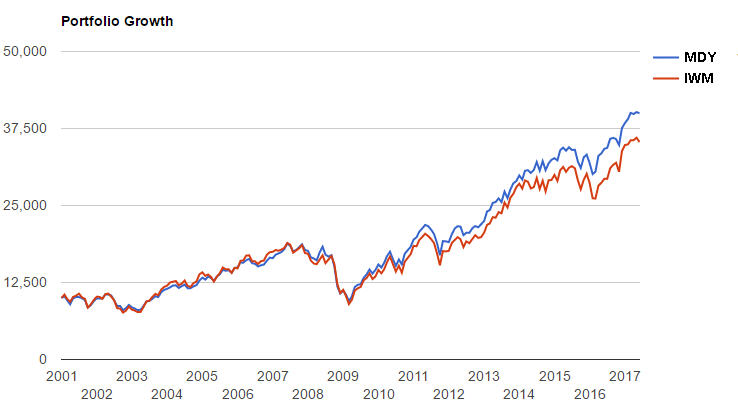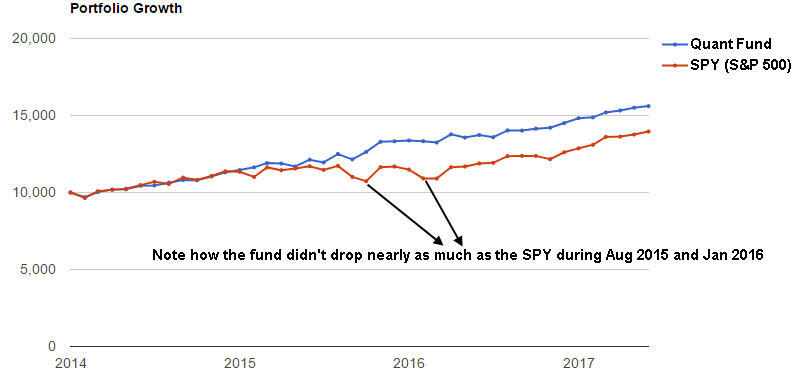The S&P 500 index is a very popular benchmark for U.S. stocks. Even Warren Buffet is a fan. For the fortune he’ll leave behind, he’s requested a 90% allocation in an S&P 500-based fund.
There are many S&P 500 mutual funds. There are also exchange-traded funds (ETFs) like the SPY (SPDR S&P 500). Despite the S&P 500’s popularity, we think there are better choices for non-TSP investing. This is true whether you buy and hold or invest actively (market timing, seasonal strategies, etc.).
Equal weighted instead of cap weighted
One problem with the S&P 500 is that it’s market cap-weighted. This means larger companies get more “weight” in the index. At the time of this article, Apple makes up 3.88% of the index. Some smaller companies have less than a 0.015% weighting.
This has several disadvantages. First, smaller companies usually grow faster. They also perform better than large stocks over the long term (more on that in a minute). In addition, cap weighting hurts diversification. There are 500 stocks in the S&P 500, but 10 companies determine almost 20% of its performance.
Fortunately, there’s a solution. Funds like RSP (Guggenheim S&P 500 Equal Weight ETF) give equal weight to each stock in the index. Since 2004, RSP has an annualized return of 9.25% compared to 8.07% for the SPY.
Smaller stocks = better returns
The S&P 500 is made up of large stocks (“large caps”). Years ago finance academics discovered small-cap stocks outperform large caps. Since 1972, the annualized return of small-caps is 11.84% compared to 10.17% for large caps.
The most popular small-cap index is the Russell 2000. A popular ETF based on the Russell 2000 is IWM (iShares Russell 2000). The IWM has outperformed the S&P 500, but we can improve our results by digging a little deeper.
Mid-cap stocks don’t get as much attention as small caps, but they’ve done even better. Since 1972, their return has been 12.04%. Since ETFs haven’t been around that long, we can only compare the MDY (mid-cap ETF) to the IWM since 2001. In addition to a higher return, the MDY had a slightly smaller drawdown in 2008 and better risk measurements.

If you want to invest in small-caps, we favor the IJR (iShares S&P SmallCap 600 Index Fund) over the IWM. It’s based on an index of 600 small-cap stocks that must pass a financial test. Since 2001, its return has been 9.60% compared to 7.99% for the IWM. Or you can do a 50/50 split between MDY and IJR for better diversification.
Going international
Since 2010, annual returns of the U.S. stocks have tripled those of foreign stocks (13.22% vs. 4.39%). This pattern probably won’t continue, though. U.S. stocks and foreign stocks go through periods of outperforming one another. From 2002-2007, foreign stocks more than doubled U.S. stock returns.
A new trend may already be underway. The EFA (iShares MSCI EAFE international ETF) is up 14.43% from January-May 2017. By comparison, the SPY only has an 8.48% gain. Almost all financial measures–such as the price/earnings ratio–suggest international stocks are a better value than U.S. stocks. And emerging markets are even cheaper than developed foreign nations.
The EFA is very similar to the I Fund. Other foreign funds may be more attractive, though. One is the EFAV (iShares Edge MSCI Min Vol EAFE ). The EFAV is similar to the EFA, but invests in lower-volatility foreign stocks. This means their prices fluctuate less. Sine 2012, it’s had a higher return than the EFA while its max drawdown was much lower (8.54% vs. 18.76% for EFA).
Similarly, the EEMV is fund based on lower-volatility emerging market stocks. It’s outperformed the more popular EEM emerging market fund with a lower drawdown.
We also like GVAL (Cambria Global Value ETF). It invests in the least expensive worldwide stock markets. It’s not a low-volatility fund, though. It’s had some large drops and fluctuations. Still, it’s outperformed the EFA and even the S&P 500 since 2015 (GVAL started trading in mid-2014). Very few international funds have done as well in that period.
Finally, there’s DLS (WisdomTree International SmallCap Fund). DLS holds small, dividend-paying stocks in developed international markts. Since it began in 2006, it’s almost tripled the return of the EFA.
For members only
We’re about to post an additional report for TSPKey members. It covers a “quant” mutual fund that’s managed more like a hedge fund. Below you can see its performance vs. the S&P 500. In addition to better returns (13.92% vs. 10.25% annually), it’s had a much better performance when stocks fall–mostly due it’s hedging feature.

There’s usually a $1 million minimum invesment for the fund. However, we found a broker who allows you to invest as little as $2,500 in an IRA. The fund stops accepting new investors afterJune 30 this year, so time is running out.
We’ll also cover a couple of other “quant” funds that have outperformed the S&P 500.
TSPKey does not give personalized investment advice. This is for informational and educational purposes only. Past and/or hypothetical performance is not an indication of future performance. In our non-TSP accounts, we currently have positions in RSP, MDY, EFA, EEMV, GVAL and DLS. Data and charts courtesy of PortfolioVisualizer.com with some modifications.


Perhaps I wasn’t reading this correctly, but if I want to invest in a mid-cap ETF, is MDY the one you favor, and is it also obtained from (iShares Russell 2000)?
Your posts are very helpful and educational, particularly when looking for options to the TSP either as additional, comparable places to invest non-TSP funds or for drawdowns for post-70 y/o investors. Thanks!
We’re glad the posts have been helpful. Yes, MDY (SPDR S&P MidCap 400 ETF) is a “favored” fund mentioned in the article. It’s based on the S&P MidCap 400 Index, which has done slightly better than the Russell 2000 over the last 25 years.